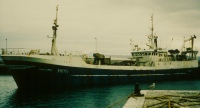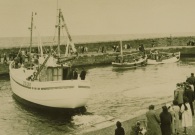Herring Home | Fishing for herring | Next
Decline of drift netting and changes in netting
There have been many changes in the 20th century. The herring fisheries reached their peak before World War I and from this time on they declined. The decline led to changing fishing patterns. Seine netting for white fish was increasingly taking over from drift netting for herring. Many East Coast boats fished for herring in summer and autumn and then turned to seining.

Two important innovations took place in herring fishing from the 1960s. The purse-net or purse seine was introduced from Norway. It was similar to the Scottish ring net that was already used on the West Coast and in the Firth of Forth, but on a bigger scale. It works by encircling the fish with a large wall of net. Wire ropes are then run through rings and the bottom of the net is drawn tight to create a sealed pocket or purse. It could be used in the open sea because the hydraulic power block enabled the nets to be hauled mechanically. The power block is basically a crane with a large rubber roller with a v-shaped cross-section on the end, which grips the purse net and draws it onboard. The main problem with purse nets is that they caught everything, large and small.

The successful mid-water pair trawl also began to be used on the East Coast in the 1960s. It used a square-meshed wingless net that was towed between two boats. Two boats gave increased power to this method.
These new methods of netting led to a short resurgence in herring fishing for about a decade. Stronger modern synthetic fibres meant that huge nets could be used and the boats became bigger and bigger. By the 1960s there was a big fall in the number of herring being caught, and much of this was due to overfishing. Some purse seining for herring continued on the Atlantic coast into the 1970s and 1980s. However, with the decline in herring, these fishing methods were increasingly used in mackerel fishing instead.